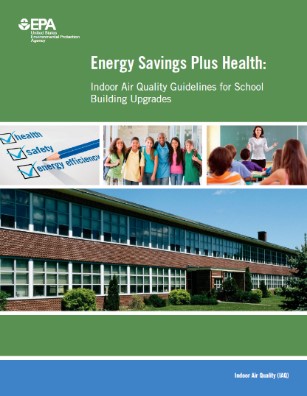By. Michele Curreri, Environmental Protection Specialist, U.S. Environmental Protection Agency
Your school is green, but is it healthy?
Increased sustainability and energy efficiency typically are the primary goals of schools “going green.” Schools can see an even greater return on investment, however, by addressing health and safety at the same time. Healthy indoor environments promote the well-being and productivity of students and staff.
Scientific evidence has demonstrated an association between poor indoor air quality (IAQ) and negative respiratory health effects. 1 Maintenance issues—such as leaky roofs, problems with HVAC systems, insufficient cleaning or excessive use of cleaning chemicals—can trigger a host of health problems, including the onset and exacerbation of asthma and allergies. Poor respiratory health increases absenteeism and reduces academic performance. Conversely, studies demonstrate that improved IAQ increases productivity and improves performance on mental tasks, such as concentration and memory, in both adults and children (U.S. EPA, 2012). For example, simply increasing classroom ventilation rates has been demonstrated to improve student health and performance, according to studies2 by the Lawrence Berkeley National Laboratory.
Improved IAQ also can improve the financial bottom line for public schools due to fewer sick days and increased average daily attendance.
How do I get started?
Schools across the country are reaping the benefits of healthy indoor environments by using practical, proven, and readily available tools. These schools are using the U.S. Environmental Protection Agency’s (EPA) IAQ Tools for Schools Framework, Action Kit, cutting-edge webinar series, mobile app, and facilities energy retrofit and upgrade guide to improve student health, boost academic performance, and reduce energy use.
 If you’re HAPPY and you know it…Assess Your School IAQ
The EPA’s School IAQ Assessment Mobile App The EPA’s School IAQ Assessment Mobile App is your “one-stop shop” for implementing IAQ management guidance from the IAQ Tools for Schools Action Kit. With actionable steps and checklists, the app assists schools and school districts in assessing facilities to protect the health of children and school staff. Download it today!
If you’re HAPPY and you know it…Assess Your School IAQ
The EPA’s School IAQ Assessment Mobile App The EPA’s School IAQ Assessment Mobile App is your “one-stop shop” for implementing IAQ management guidance from the IAQ Tools for Schools Action Kit. With actionable steps and checklists, the app assists schools and school districts in assessing facilities to protect the health of children and school staff. Download it today!
To get started, EPA’s IAQ Tools for Schools Framework3 and Action Kit4 provide straightforward, minimal-cost solutions that are accessible for immediate implementation. Integrating these effective and affordable activities into daily operations can safeguard and improve IAQ and achieve significant health and performance improvements for students and staff.
These results-oriented tools provide strategies and detailed guidance to establish and sustain a successful IAQ management program. The IAQ Tools for Schools Framework’s flexible and adaptable structure allows all schools—regardless of location, size, budget, or condition—to launch, reinvigorate, and sustain an effective IAQ management program. The Framework enables school district officials to take action in implementing IAQ management plans that address health, academic performance, and facility efficiency.
The IAQ Tools for Schools Framework also outlines Six Key Drivers that are common elements of successful IAQ management programs. The Key Drivers are strategies for implementing technical solutions for addressing IAQ risks using a cycle of continuous assessment, planning, action, and evaluation:
- Organize your program.
- Communicate with stakeholders.
- Assess your school environment and the well-being of the occupants.
- Plan your actions based on your assessments and other important factors.
- Act to solve or prevent IAQ problems.
- Evaluate the effectiveness of your program.
This cyclical framework allows schools to prepare, implement, and receive feedback on their IAQ management plans, which is valuable in making future modifications to the plans. In addition, systematically implementing the Seven Technical Solutions for Effective IAQ Management will consistently lead to healthier school environments. The Seven Technical Solutions involve implementing the following:
- Quality inspection, operation, and maintenance of your HVAC system
- Active control of moisture and mold
- Strong integrated pest management
- Effective, consistent cleaning and maintenance activities
- Smart low-emitting, low-toxicity materials selection
- Aggressive source control
- Integrated energy management
The IAQ Tools for Schools Framework and Action Kit are designed to help you and your school think about your IAQ goals more strategically and develop effective plans for accomplishing those goals. To make it even simpler, you can utilize these materials in the free School IAQ Assessment Mobile App. The app provides easy, on-the-go access to IAQ checklists that address critical building-related health issues—such as ventilation, cleaning and maintenance, airborne asthma triggers, and integrated pest management—and can help you streamline IAQ performance goals.
Energy efficiency upgrades—what’s IAQ got to do with it?
If your school is planning an energy retrofit or other building improvements, EPA’s Energy Savings Plus Health: Indoor Air Quality Guidelines for School Building Upgrades5 can serve as a useful tool to help navigate specific construction and retrofit processes integrating energy efficiency upgrades with IAQ, as well as protecting occupant health and safety. This document describes opportunities for reducing energy costs and improving student health while focusing on 23 priority issues and contaminants commonly associated with building upgrades.
For example, North Penn School District of Lansdale, Pennsylvania reduced energy use by 35 percent in 2013 and has reduced energy expenditures by more than $1 million per year while improving IAQ. North Penn School District used Energy Savings Plus Health in a recent renovation of an elementary school, applying its recommendations and practices. They found it helped them ensure a safe environment during construction and improve IAQ when the building was complete and occupied by students and staff.
Visit the Energy Savings Plus Health website to learn more about protecting IAQ during energy efficiency upgrades, so you can “go healthy” while “going green.”
Don’t wait—get started today!
Tens of thousands of schools nationwide have already successfully implemented the EPA’s IAQ Tools for Schools Framework, Action Kit, Mobile App, and Energy Savings Plus Health: Indoor Air Quality Guidelines for Building Upgrades guidance, and you can, too!
Through continued education and use of EPA’s IAQ Tools for Schools resources, you can better manage your school’s indoor air quality and improve student health and academic performance while going green!
References
- EPA, Office of Research and Development: A Decade of Children’s Environmental Health Research: Highlights From EPA’s Science to Achieve Results Program. 2007. EPA/600/S-07/038.
- S. Environmental Protection Agency. 2012. Student Health and Academic Performance—Quick Reference Guide. Retrieved from http://www.epa.gov/sites/production/files/2014-08/documents/student_performance_findings.pdf (Accessed December 28, 2015)
- S. Environmental Protection Agency. IAQ Tools for Schools Framework. Retrieved from http://www.epa.gov/sites/production/files/2014-10/documents/tfs_framework_success_3_pager.pdf (Accessed December 28, 2015)
- S. Environmental Protection Agency. IAQ Tools for Schools Action Kit. Retrieved from www.epa.gov/iaq-schools/indoor-air-quality-tools-schools-action-kit (Accessed December 28, 2015)
- S. Environmental Protection Agency. Energy Savings Plus Health: Indoor Air Quality Guidelines for School Building Upgrades. www.epa.gov/iaq-schools/iaq-guidelines-school-building-upgrades-energy-savings-plus-health (Accessed December 28, 2015)
About Michele Curreri:
Michele Curreri is an Environmental Protection Specialist at the U.S. Environmental Protection Agency, where she specializes in indoor air quality issues in schools. With more than 25 years of experience working with K–12 school districts, Ms. Curreri has spent the past 15 years assisting school districts in designing, building, and maintaining healthy, high-performing schools. Her experience includes the design, development, implementation, and evaluation of EPA’s Indoor Air Quality Tools for Schools guidance.




